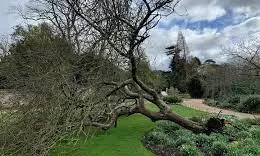
Cambridge University artist creates unique ink from clone of Isaac Newton's apple tree
text_fieldsMost people are familiar with the tale of Sir Isaac Newton formulating his theory of gravity while observing an apple fall from a tree in the 1660s.
Recently, an artist at Cambridge University undertook a fascinating project involving a clone of Newton's famous apple tree. This particular clone had been planted at Cambridge University's Botanic Garden in 1954 but met its fate in high winds in February 2022.
The garden's artist-in-residence, Nabil Ali, embarked on the unusual endeavour of extracting ink from the bark of this historical apple tree clone and employing the resulting ink to create a remarkable artwork featuring 68 apples. The ink production process involved peeling away bark from the tree, soaking it for a day and a half in Ali's workshop, followed by grinding it, boiling to release tannin, and finally adding the chemical compound alum.
"To our knowledge, this is the first time anyone has discovered the colours hidden within a descendant of Newton's inspiring tree. I thought I'd end up with black pigment, but it's a dark golden yellow. I'm calling it Newton's Gold," said Ali.
This unique exhibit, showcasing replicas of the 68 apples, is scheduled to premiere on Apple Day, set for October 22, at the university's garden.
Dr. Samuel Brockington, curator of Cambridge University's Botanic Garden, revealed that the genome of the Cambridge tree was sequenced as part of the Darwin Tree of Life project. "From this analysis, our tree seems identical to other descendants, and so we can say with confidence that ours is a direct clone of the original tree in Grantham, which also fell in a gale in the 19th century," he said.
Dr. Brockington commended Nabil Ali's artistic creation, emphasising that it presents an inspiring way to engage people with the natural world through art and performance.
The original apple tree, grown in the garden of Newton's childhood home, Woolsthorpe Manor near Grantham in Lincolnshire, reportedly succumbed to a gale in the early half of the 19th century.























